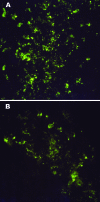Thottapalayam virus, a prototype shrewborne hantavirus
- PMID: 18214168
- PMCID: PMC2254531
- DOI: 10.3201/eid1307.070031
Thottapalayam virus, a prototype shrewborne hantavirus
Abstract
Thottapalayam virus (TPMV) has been placed in the genus Hantavirus of the family Bunyaviridae by virtue of its morphologic features and overall genetic similarities to well-characterized rodentborne hantaviruses. This virus has been isolated from the Asian house shrew (Suncus murinus); however, whether TPMV is naturally harbored by an insectivore host or represents spillover from a rodent reservoir host is unknown. Our analysis of published and unpublished data on the experimental host range, genetics, and molecular phylogeny of TPMV supports coevolution of TPMV with its nonrodent reservoir host. Future studies on the epizootiology of TPMV and investigations of new shrewborne hantaviruses will provide additional insights into the evolutionary origin of hantaviruses in their rodent and insectivore reservoir hosts. Such investigations may also provide clues about determinants of hantavirus pathogenicity and virulence.
Figures



References
-
- Schmaljohn CS, Hasty SE, Harrison SA, Dalrymple JM. Characterization of Hantaan virions, the prototype virus of hemorrhagic fever with renal syndrome. J Infect Dis. 1983;148:1005–12. - PubMed
Publication types
MeSH terms
Grants and funding
LinkOut - more resources
Full Text Sources
Medical
